This article describes an overview of ohmmeter, circuit diagram, types, and applications. There are numerous types of electric measuring devices available for testing electrical and electronic devices and circuits.
Measuring devices like voltmeters, ammeters, ohmmeters, and multimeters are used for checking the wiring connections and devices’ healthiness. The ohmmeter is a measuring device that measures the resistance of the circuit. In the subsequent sections, we will discuss how an ohmmeter calculates the resistance of the circuit and what are the types of ohmmeters.
What is an Ohmmeter?
An ohm meter is a device used to measure the electrical resistance of a circuit or component. The unit of resistance is the ohm. The property of the material that opposes the flow of electric current through it is called resistance. Every material whether conductor, semiconductor, or insulator except the superconductor has resistance.
The materials with high conductivity have lower resistance and on the other hand, the insulating materials have high resistance. Therefore, different types of ohmmeters with different sensitivity are used to measure resistance.
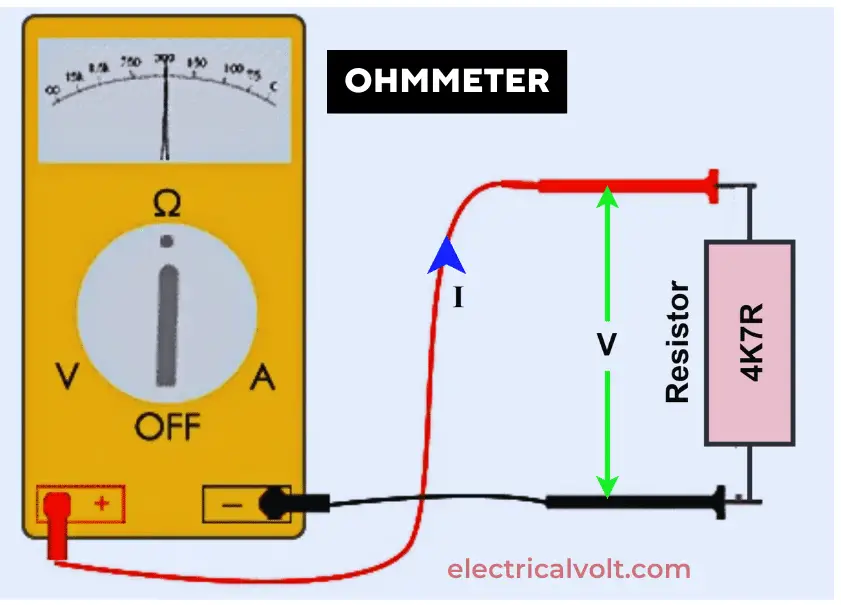
Micro-ohmmeter is used to measure low resistance whereas a mega-ohmmeter is used to measure high resistance. We apply a small voltage to its circuit and we also measure its resulting current flow. Ohm meter uses Ohm’s law to measure resistance.
Micro Ohm-Meters: A micro ohm meter is a highly sensitive measuring instrument used to measure extremely low electrical resistance. The micro ohmmeter is used to test and measure the resistance of electrical power systems and equipment such as transformers, motors, and switches. The conventional ohmmeter measures the resistance values in the range of ohms to mega-ohms, on the other hand, the micro ohmmeter is designed to measure resistance values in the micro-ohm (μΩ) and milli-ohm (mΩ) ranges.
Working of Micro Ohm meter: A micro Ohm meter injects a high current into the test sample and measures the voltage drop across it. By using Ohm’s law (R=V/I), the instrument accurately calculates the resistance of the object under test.
Mega Ohm meter: A mega Ohm meter, also known as a megger, is a specialized instrument used to measure the electrical insulation resistance of high-voltage equipment and cables. It is designed to measure resistance values in the order of megaohm (MΩ)to Giga-ohm(GΩ), which is much higher than the range of a conventional ohm meter.
Working of Mega Ohm meter: A mega Ohm meter applies a high voltage in the range of 500 to 5000 volts to the insulation specimen being tested. The meter then measures the current drawn by the object. Now, by using Ohm’s law, the meter calculates the insulation’s resistance by dividing the applied voltage by the measured current. The mega ohm meter is a very important tool for measuring the insulation resistance of the insulating materials used in cables, motors, and generators.
Working Principle of Ohmmeter
The Ohmmeter working principle is very simple and it is based on Ohm’s law. The Ohmmeter is connected in the series with the circuit or component whose resistance is to be measured. The ohmmeter applies a voltage to the circuit or component and it measures the magnitude of electric current flowing through the component.
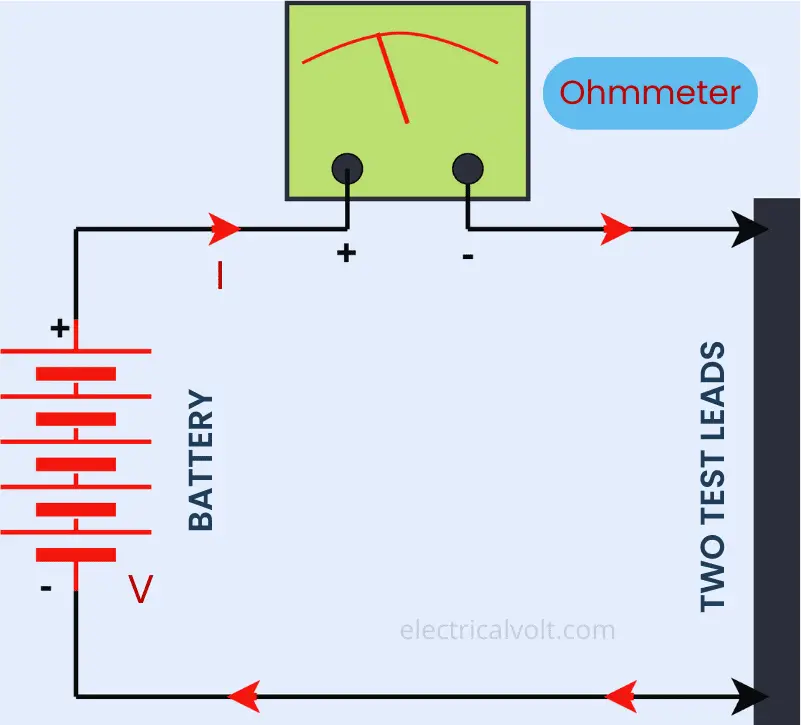
The internal circuitry of the ohmmeter then calculates the resistance using Ohms’s law by dividing voltage by current. Thus, the ratio of voltage to current is the resistance of the component or circuit.

The ohm meter has a d’Arsonval movement device named after French physicist Jacques-Arsène d’Arsonval and two test leads. The d’Arsonval movement device has a coil of wire. The battery, ohmmeter, and the component or circuit being tested are connected in the series.
After switching on the battery, the current flows through the coil, and the coil produces a magnetic field. The interaction of the magnetic field produced by the coil and the magnetic field of the permanent magnet produces a torque that causes coil rotation on its axis. The coil rotation depends on the magnitude of the current flowing in the coil.
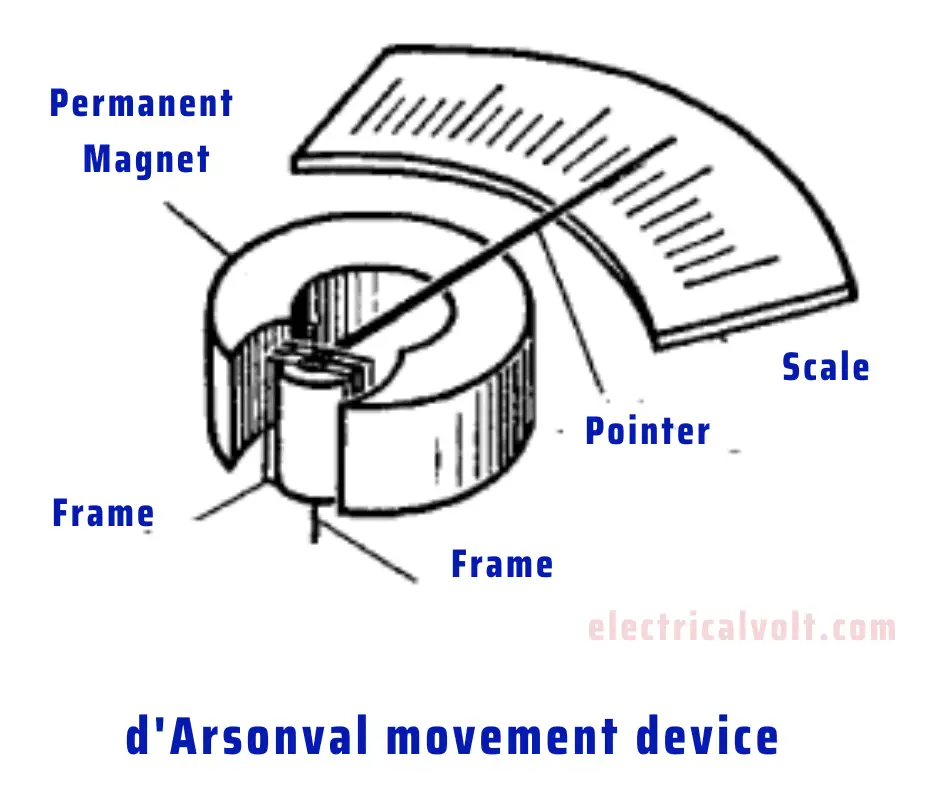
When the current through the coil is zero, it means an open circuit and no current flows through the coil. It causes no deflection of the pointer and the ohmmeter shows the infinite (∞)resistance on the pointer scale. Now, with an increase in current, the pointer deflects from the infinite to the zero sides on the scale, and it shows a decrease in resistance.
Types of Ohmmeters
There are three types of ohmmeters. They are-
- Series Type Ohmmeter
- Shunt Type Ohmmeter
- Multi-Range Ohmmeter
Now, we will discuss each type of ohmmeter in detail.
1. Series Ohmmeter
The circuit diagram of series type ohmmeter is shown below.
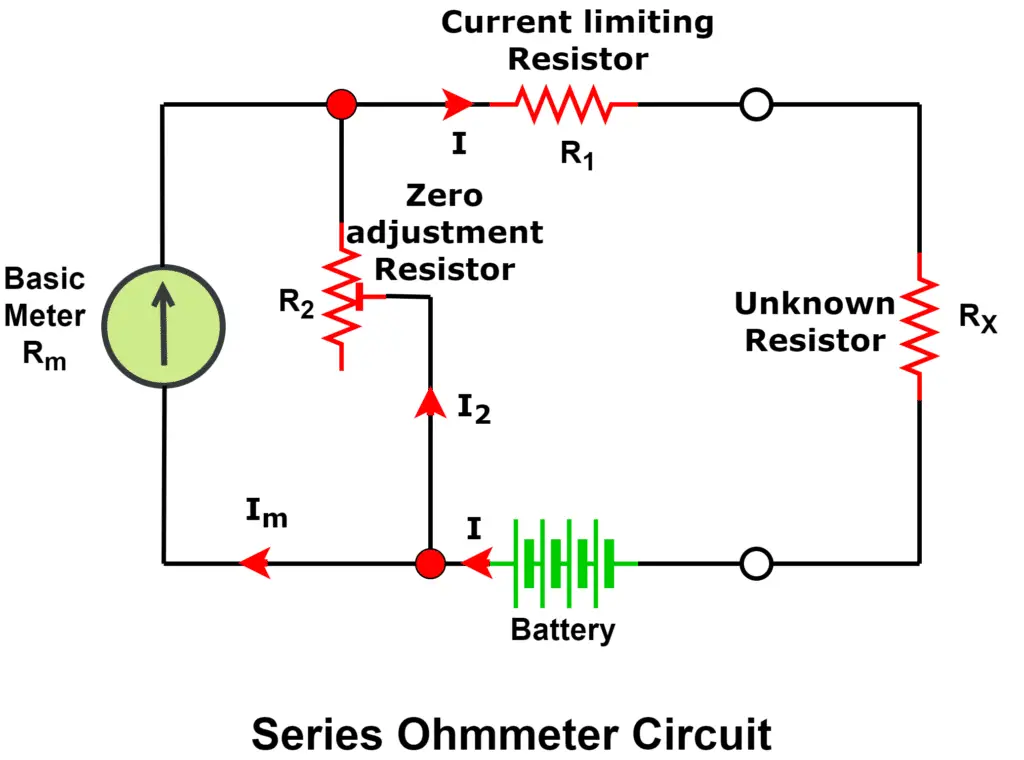
The series ohmmeter circuit comprises the following components.
- Battery
- Zero adjustment resistor(R)
- Current limiting resistor
- d’Arsonval movement device
The unknown resistance is connected in the series with the ohmmeter, therefore it is called the series ohmmeter. The resistance R2 is used for zero adjustments of the reading. The scale of the series-type ohmmeter is given below.

The deflection on the ohmmeter for unknown resistance will be as follows.
Case 1: If we short the A to B terminal, it means our unknown resistance value is equal to zero. In this condition, the current value in the meter is maximum. If the meter reading on the scale exceeds zero value, we adjust it to zero by adjustable resistance R2 The meter needle goes on the right side on the higher side.
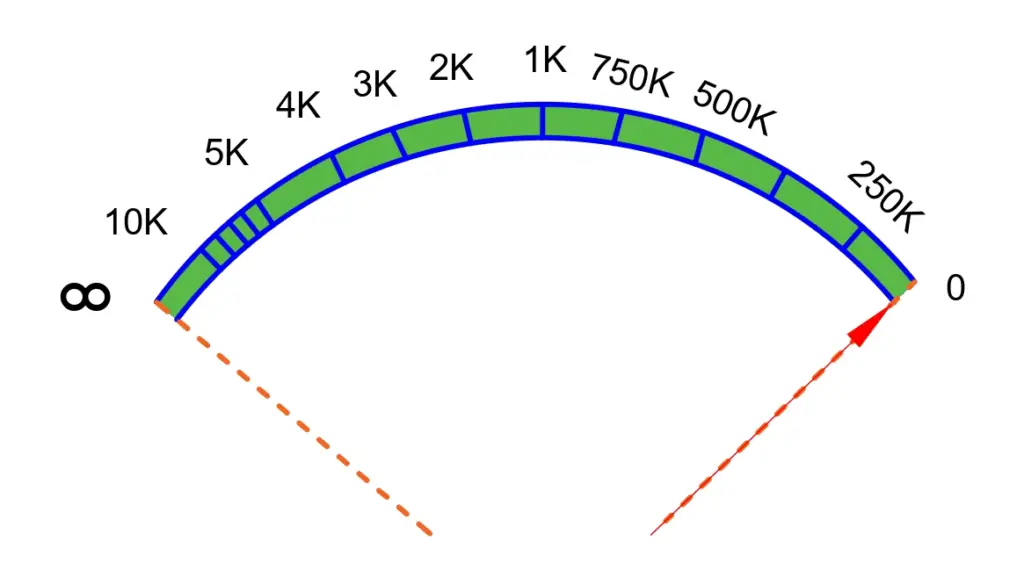
Case 2: If we keep the terminal A and B open, it means the circuit is open circuit and the value of unknown resistance is infinite. No current flow through the ohmmeter in this case because the circuit does not complete. Now meter deflection goes on the left side on zero deflection and shows an infinite value.
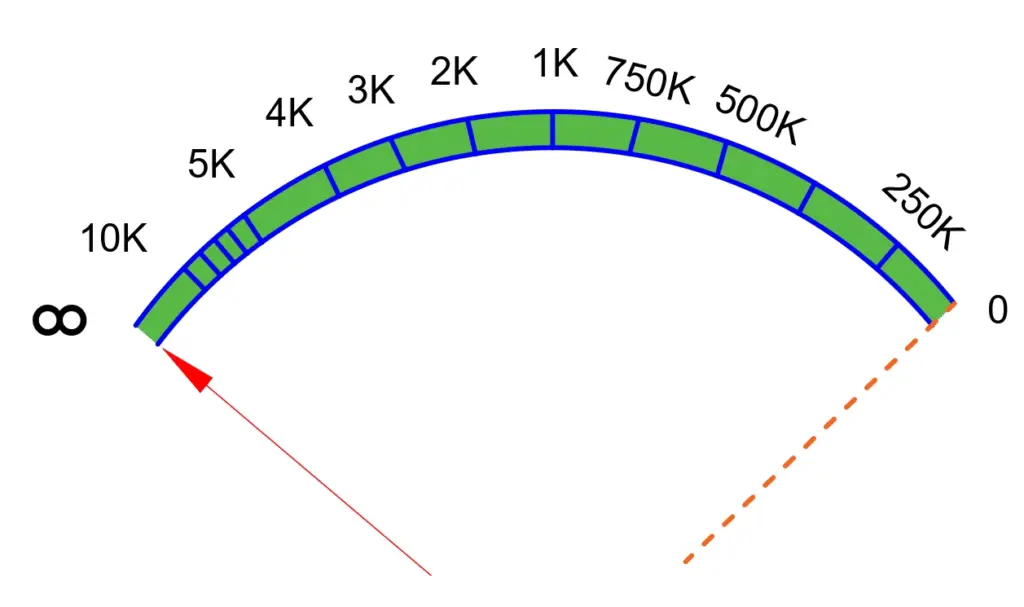
The zero and infinite value on the ohmmeter scale is on the right and left side respectively.
2. Shunt Type Ohmmeter
The shunt-type ohmmeter is connected in parallel with an unknown resistor. This type of meter is suitable for calculating low-value resistance. The circuit diagram of shunt type ohmmeter is given below.
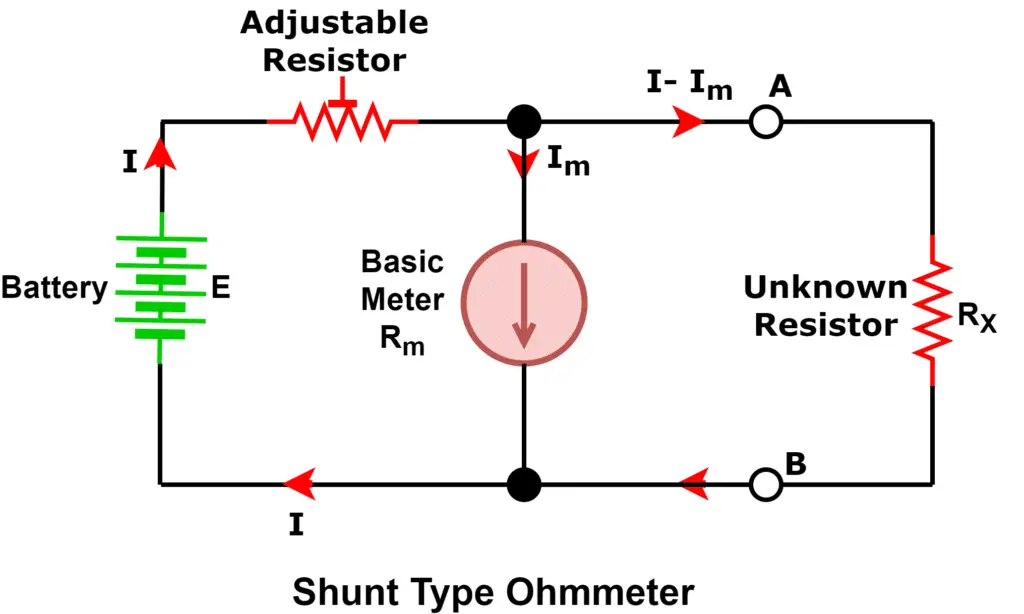
The scale marking of this meter is just opposite to the series ohmmeter.
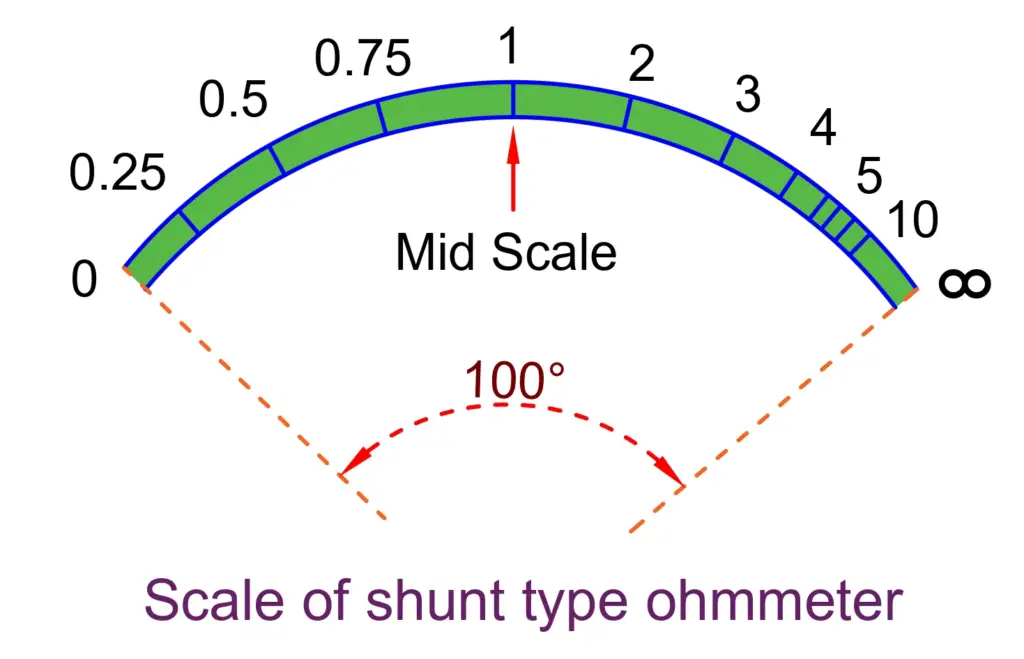
When we short terminals A and B, it means resistance between the points A and B is zero. The entire current will pass through the low resistance path and thus the current flowing through the meter is zero. The needle of the meter will remain on the left side showing zero resistance.
Now, if there is no resistance connected across points A and B, then the meter should show infinite resistance. In this condition, the current does not flow through terminal A to B, because it is an open circuit. Thus, the entire current flows through the meter, and the needle deflects to the right side of the scale and shows infinite resistance.
3. Multi-range Ohmmeter
Multi-range ohmmeters have multiple range settings that can be adjusted to measure the resistance values in the different ranges. Thus, we can measure the resistance from lower ranges to higher ranges. The circuit diagram of the multi-range ohmmeter is shown below.
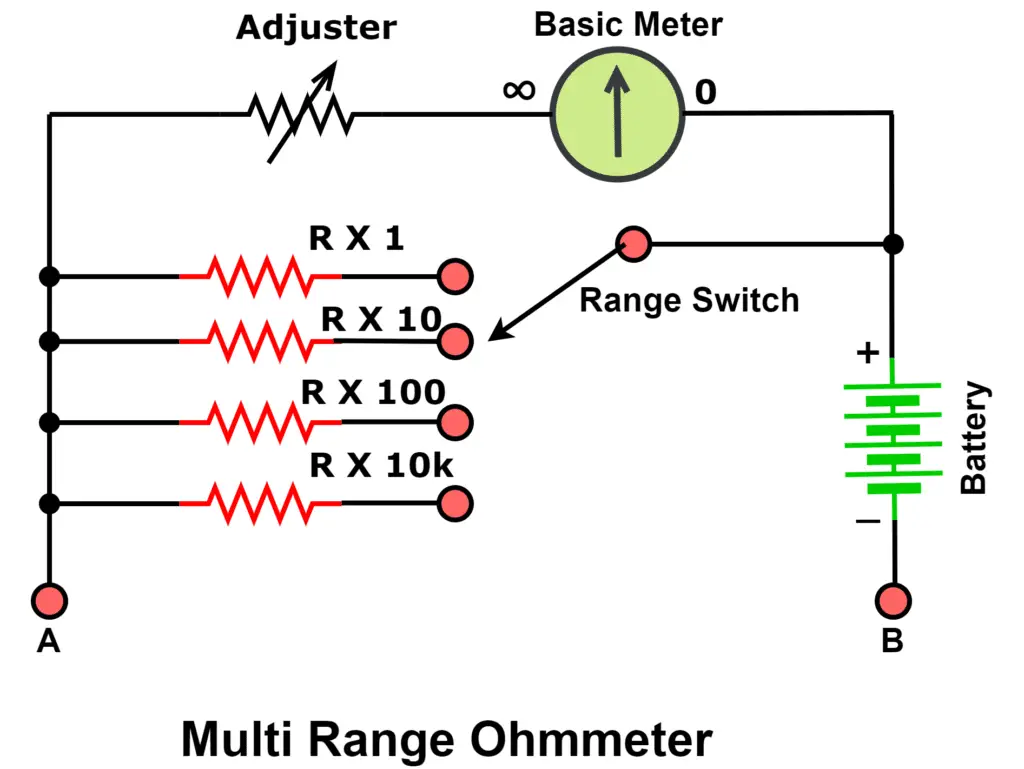
Applications of Ohmmeter
The followings are the applications of ohmmeter.
- The meter is used to find the continuity of the circuit and circuit elements. If the circuit component is open or defective, no current flow through the circuit or the component. It is a widely used tool for troubleshooting a faulty circuit.
- It is used to check electronic components and circuits.
- It is used for checking the continuity of the PCB for open/short circuits of the PCB circuit.
- The meter is used to measure the resistance of motor winding and other electrical equipment.
- The meter is used to test the heating element for open & short circuits.
Advantages of Ohmmeter
The followings are the advantages of Ohmmeter.
- Accuracy
- Speed
- Convenience
- Versatility
- Reliability
- Low power consumption
- No Hysteresis loss
- Not affected by stray fields